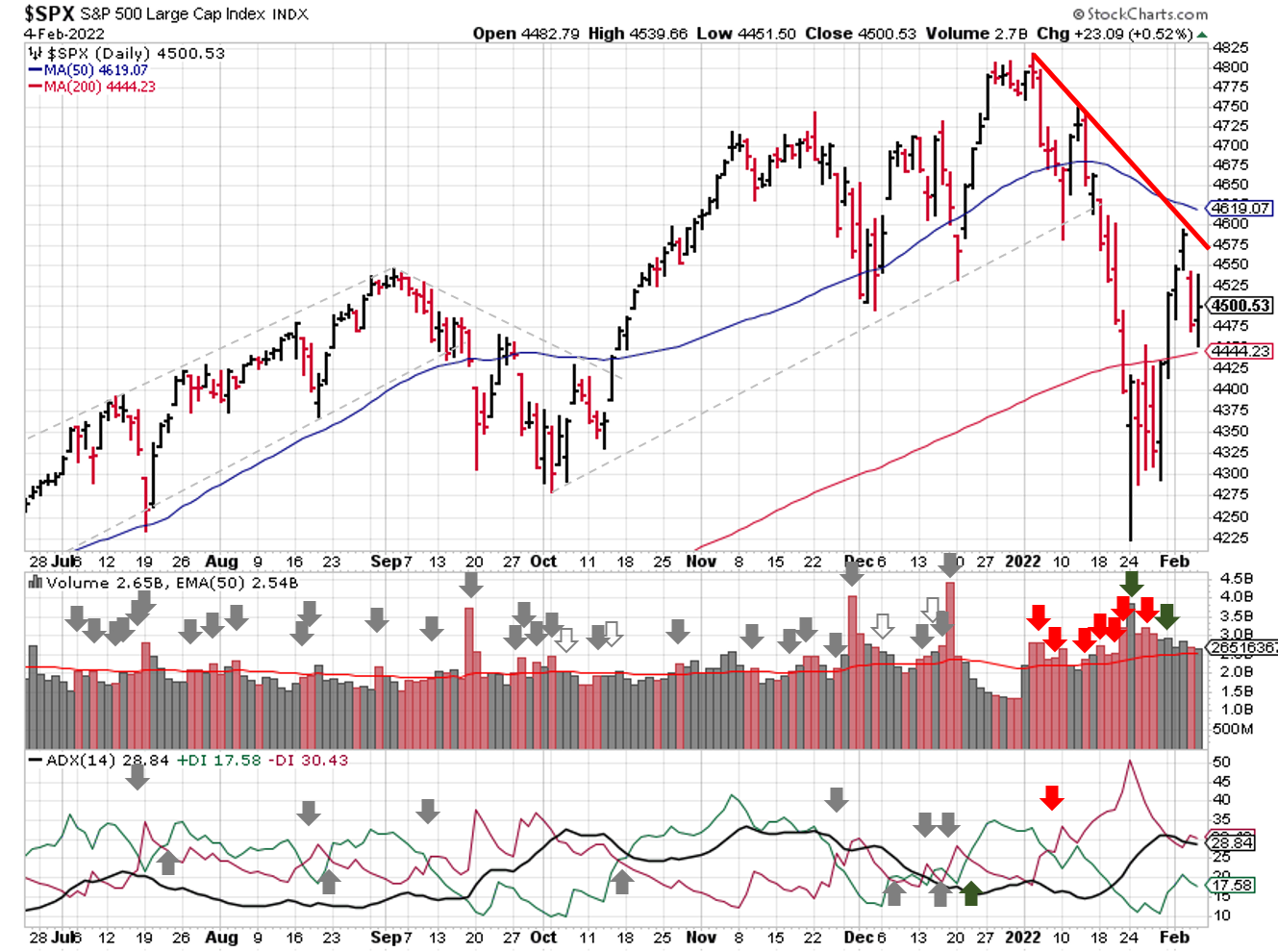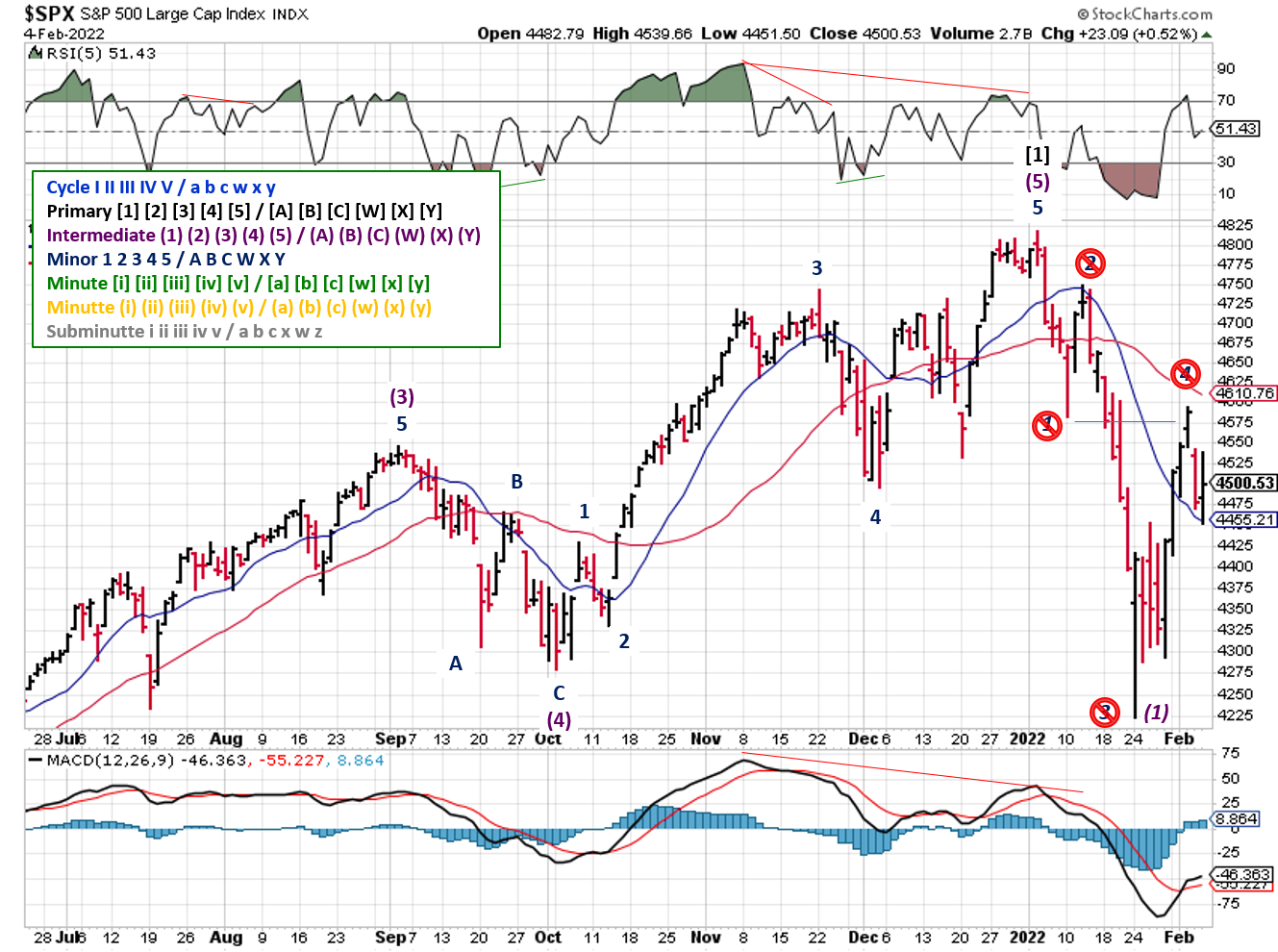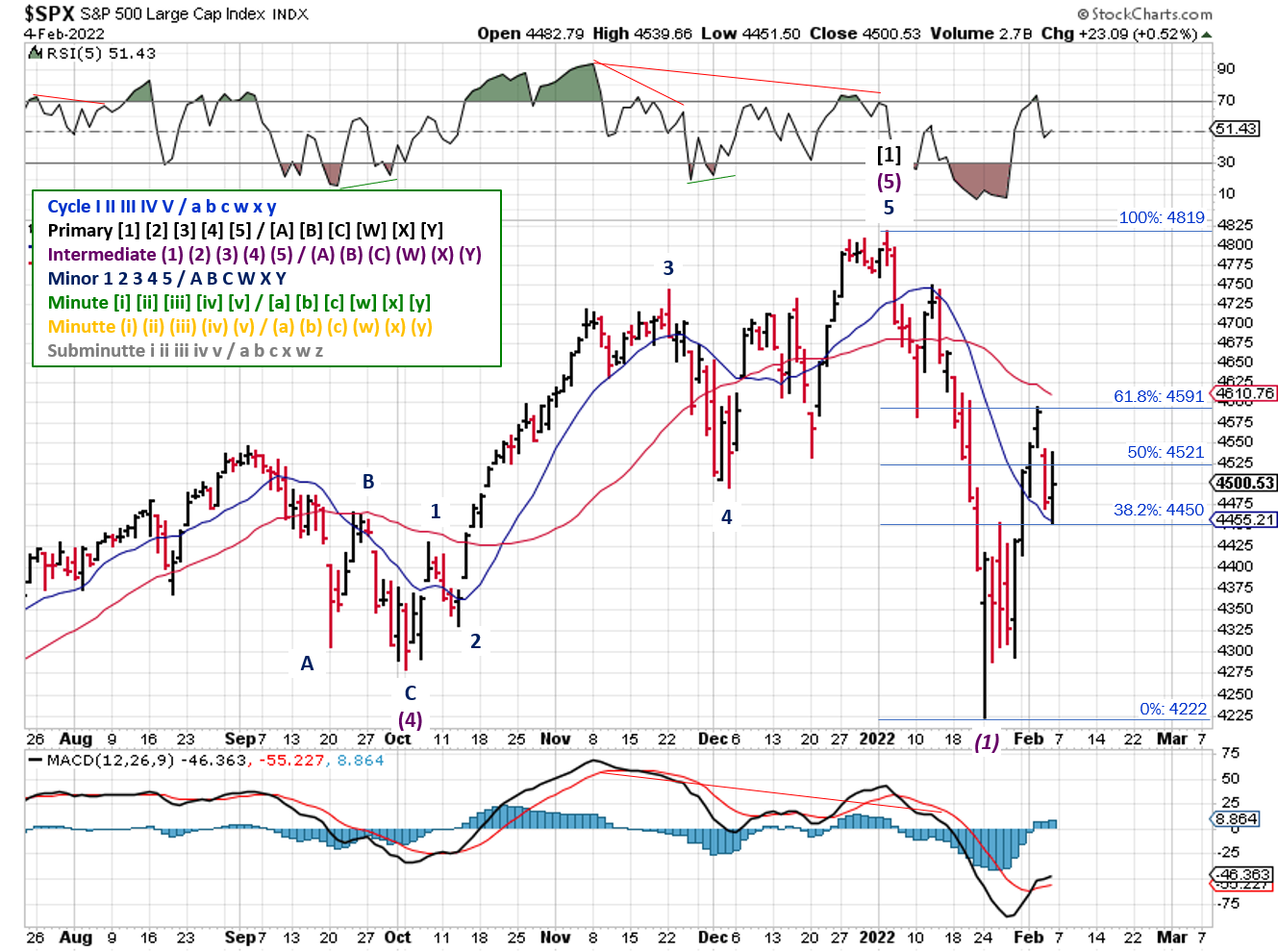Stock Market Outlook
For The Week Of February 6th = Downtrend
INDICATORS
-
ADX Directional Indicators: Downtrend
Price & Volume Action: Mixed
Elliott Wave Analysis: Downtrend
The S&P500 ($SPX) rallied hard, then eased into the close, gaining ~1.5% for the week. The downward trendline remains in place, with the index closing near that level on Wednesday then retreating.
2022-02-06-SPX Trendline Analysis - Daily
The ADX remains bearish. The price/volume signal moved back to mixed last Monday. Jan 24th marked the start of a possible rally attempt, and Monday’s trading action marked a follow-through day, with a rise on higher trading volume.
But the index remains below the 50-day moving average, and the price charts of most leading companies are far from proper buy points. Most are still working on the left-side (corrective side) of new price patterns, like the “cup with handle”. When companies with excellent fundamentals start breaking out of proper price patterns, you’ll know the market is ready to rally.
2022-01-30-SPX Elliott Wave Analysis - Daily - Primary 2 - Minor 1
For Elliott Wave, the signal remains bearish. Wednesday’s close was higher than the Jan 10th low, so that invalidates the Minor 1 wave from last week. Considering last week’s discussion of time compression, it’s possible/probable that the entire Intermediate (1) completed on Feb 24th.
2022-02-06-SPX Elliott Wave Analysis - Daily - Primary 2
The SPX was range-bound between the 62% and 32% Fibonacci levels. last week. Since the index retraced more than 50% of the decline from the Jan 3rd high, so price action meets the minimum criteria for a corrective Intermediate Wave (2) move (remember that during downtrends, corrective moves are to the upside – i.e. a rally).
Looking ahead, it's entirely possible we plunge further from here, but heading back toward all time highs isn’t out of the question either. Wave (2) can retrace all of (1); back to the Jan 3rd high, and remain valid. That’s why other signals are important; they’re likely to turn bullish before Elliott Wave sorts itself out.
COMMENTARY
Last week's January jobs report blew away expectations, and likely sealed the deal in terms of the Fed raising interest rates in March. The next question is how much, followed by what's next. The interest rate futures curve implies that there's now a 33% chance the Fed raises rates 0.5% in March. And many investment banks are making headlines for their predictions of up to SIX rate hikes this year! Regardless, until the Fed actually raises rates, we're likely to see continued volatility in the market.
Speaking of volatility, there was a lot of that to go around last week; this time tech companies like Facebook/Meta, Amazon, Google, Snapchat. Weighted indexes like the SPX will avoid the carnage as long as mega-cap stocks like Apple, Google, and Amazon hold up. Quarterly earnings drove the the unusual movements, so keep in mind that year-over-year increases are increasingly harder to achieve thanks to great numbers in 2020. In the current market environment, companies that miss on headline numbers (revenue/profit) see their stock prices severely punished (i.e. Facebook $FB).
Best To Your Week!
If you find this research helpful, please tell a friend. If you don't find it helpful, tell an enemy.
I regularly share articles and other news of interest via on Twitter (@investsafely), Facebook, Linkedin, and Instagram (@investsafely)

How to Make Money in Stocks: A Winning System in Good Times and Bad.
It's one of my favorites.
Invest Safely, LLC is an independent investment research and online financial media company. Use of Invest Safely, LLC and any other products available through invest-safely.com are subject to our Terms of Service and Privacy Policy. Not a recommendation to buy or sell any security.
Charts provided courtesy of stockcharts.com.
For historical Elliott Wave Analysis, go to ELLIOTT WAVE lives on by Tony Caldaro. Other interpretations can be found at: Pretzel Logic, and 12345ABCDEWXYZ
Once a year, I review the market outlook signals as if they were a mechanical trading system, while pointing out issues and making adjustments. The goal is to give you to give you an example of how to analyze and continuously improve your own systems.
- 2015 Performance - Stock Market Outlook
- 2016 Performance - Stock Market Outlook
- 2017 Performance - Stock Market Outlook
- 2018 Performance - Stock Market Outlook
- 2019 Performance - Stock Market Outlook
- 2020 Performance - Stock Market Outlook
IMPORTANT DISCLOSURE INFORMATION
This material is for general communication and is provided for informational and/or educational purposes only. None of the content should be viewed as a suggestion that you take or refrain from taking any action nor as a recommendation for any specific investment product, strategy, or other such purpose. Certain information contained herein has been obtained from third-party sources believed to be reliable, but we cannot guarantee its accuracy or completeness.
To the extent that a reader has any questions regarding the applicability of any specific issue discussed above to his/her individual situation, he/she is encouraged to consult with the professional advisors of his/her choosing. Invest Safely, LLC is not a law firm, certified public accounting firm, or registered investment advisor and no portion of its content should be construed as legal, accounting, or investment advice.
The material is not to be construed as an offer or a recommendation to buy or sell a security nor is it to be construed as investment advice. Additionally, the material accessible through this website does not constitute a representation that the investments described herein are suitable or appropriate for any person.
Hypothetical Presentations:
Any referenced performance is “as calculated” using the referenced funds and has not been independently verified. This presentation does not discuss, directly or indirectly, the amount of the profits or losses, realized or unrealized, by any reader or contributor, from any specific funds or securities.
The author and/or any reader may have experienced materially different performance based upon various factors during the corresponding time periods. To the extent that any portion of the content reflects hypothetical results that were achieved by means of the retroactive application of a back-tested model, such results have inherent limitations, including:
Model results do not reflect the results of actual trading using assets, but were achieved by means of the retroactive application of the referenced models, certain aspects of which may have been designed with the benefit of hindsight
Back-tested performance may not reflect the impact that any material market or economic factors might have had on the use of a trading model if the model had been used during the period to actually manage assets
Actual investment results during the corresponding time periods may have been materially different from those portrayed in the model
Past performance may not be indicative of future results. Therefore, no one should assume that future performance will be profitable, or equal to any corresponding historical index.
The S&P 500 Composite Total Return Index (the "S&P") is a market capitalization-weighted index of 500 widely held stocks often used as a proxy for the stock market. Standard & Poor's chooses the member companies for the S&P based on market size, liquidity, and industry group representation. Included are the common stocks of industrial, financial, utility, and transportation companies. The S&P is not an index into which an investor can directly invest. The historical S&P performance results (and those of all other indices) are provided exclusively for comparison purposes only, so as to provide general comparative information to assist an individual in determining whether the performance of a specific portfolio or model meets, or continues to meet investment objective(s). The model and indices performance results do not reflect the impact of taxes.
Investing involves risk (even the “safe” kind)! Past performance does not guarantee or indicate future results. Different types of investments involve varying degrees of underlying risk. Therefore, do not assume that future performance of any specific investment or investment strategy be suitable for your portfolio or individual situation, will be profitable, equal any historical performance level(s), or prove successful (including the investments and/or investment strategies describe on this site).





